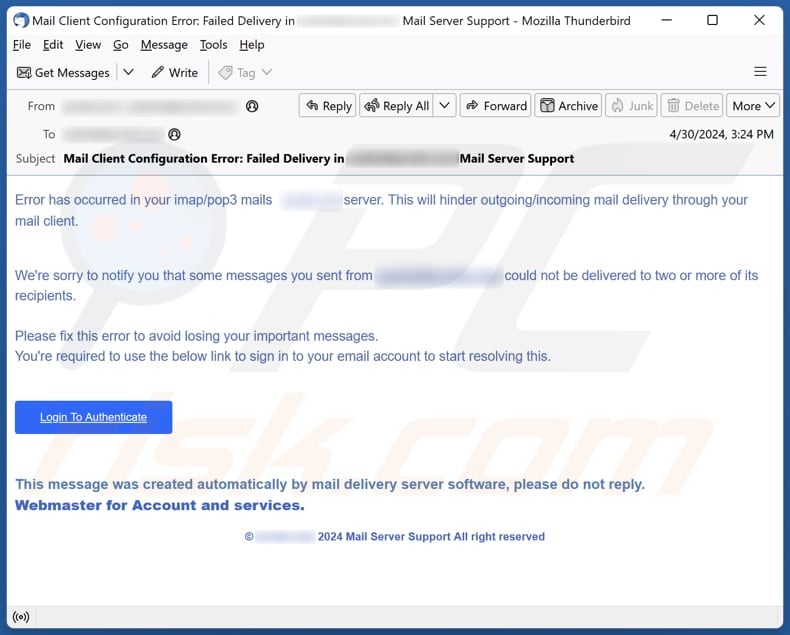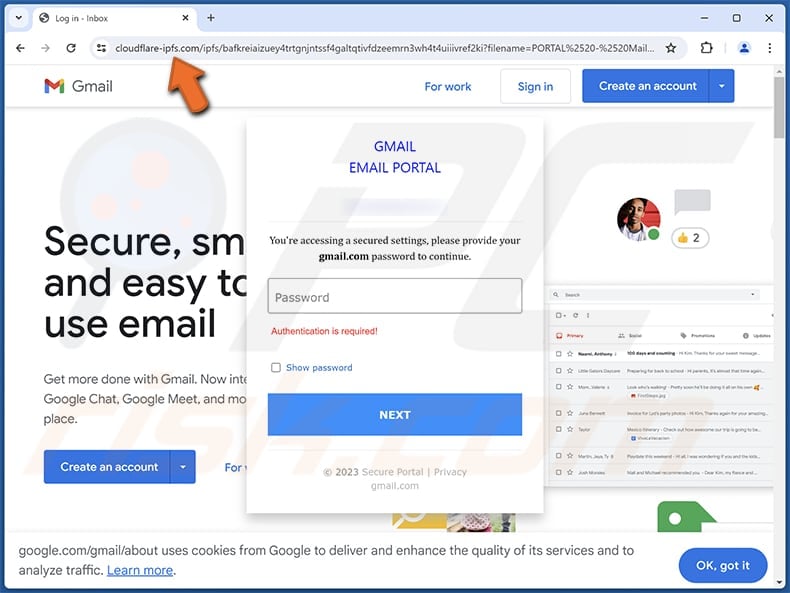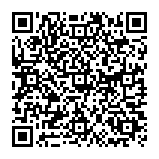How to identify scams like "Error In Your IMAP/POP3 Mails Server"
![]() Written by Tomas Meskauskas on
Written by Tomas Meskauskas on
What kind of scam is "Error In Your IMAP/POP3 Mails Server"?
Our analysis of the email revealed that it is a phishing email. Scammers behind this phishing campaign aim to deceive recipients into believing that they have received a notification from an email service provider. Their ultimate goal is to extract personal information from unsuspecting recipients.

More about the "Error In Your IMAP/POP3 Mails Server" scam email
This phishing email falsely claims to be from a mail server support team. It informs the recipient about an error in their mail client configuration hindering outgoing and incoming mail delivery. It suggests that messages sent from the recipient's account could not be delivered and urges them to fix the error to avoid losing important messages.
The email includes a link ("Login To Authenticate") prompting the recipient to sign in to their email account to solve the supposed issue. However, clicking the provided link (button) opens a phishing website masquerading as the Gmail login page. It is important to note that the site may pose as another email service provider.
The phishing page instructs to provide an email account password to continue. Once entered, the password is sent to scammers, enabling them to access the victim's email account. With access to an email account, scammers may send phishing emails or malware to the recipient's contacts.
Also, they may look for personal information (e.g., names, phone numbers, credit card details) or try to access accounts linked to the victim's email account or those using the same login credentials.Thus, it is strongly recommended not to open links provided in shady emails or provide information on pages opened through such emails.
| Name | Error In Your IMAP/POP3 Mails Server Scam |
| Threat Type | Phishing, Scam, Social Engineering, Fraud |
| Fake Claim | An error has occurred in the recipient's mail server |
| Disguise | Notification from an email service provider |
| Symptoms | Unauthorized online purchases, changed online account passwords, identity theft, illegal access of the computer. |
| Distribution methods | Deceptive emails, rogue online pop-up ads, search engine poisoning techniques, misspelled domains. |
| Damage | Loss of sensitive private information, monetary loss, identity theft. |
| Malware Removal (Windows) | To eliminate possible malware infections, scan your computer with legitimate antivirus software. Our security researchers recommend using Combo Cleaner. |
Similar scam emails in general
It is common for phishing emails to pretend to be from legitimate sources (e.g., real people or companies) and use urgency to make recipients act fast without thinking. Scammers use such emails to steal credit card details, login credentials, social security numbers, or other details. Pretty often, phishing emails contain links to fake websites.
Also, these emails can contain malicious links or files. Some examples of similar emails are "Mailbox Update", "Request To Cancel Your Services", and "Your Password Changed".
How do spam campaigns infect computers?
When threat actors distribute malware via email, they send emails with malicious attachments or links. They try to deceive recipients into activating malware through these files or links. Malware can infect computers when users open malicious executables, enable macros in harmful MS Office documents, run malicious scripts, or take similar actions.
Clicking on malicious links in emails can result in accessing websites that host malware. These websites may automatically download malicious files or apps (trigger drive-by downloads), or they might use deception to persuade visitors into downloading and running malware on their computers.
How to avoid installation of malware?
Download apps and files only from reputable sources, such as official websites and app stores. Avoid downloading pirated software or tools intended to bypass software activation. Always inspect emails before opening any links or attachments, particularly if they are unexpected or from unfamiliar senders.
Avoid clicking ads, pop-ups, download buttons, or warnings on dubious websites. Keep your operating system and software up to date. Additionally, utilize a trusted security solution and regularly scan your computer for unwanted applications. If you have already opened malicious attachments, we recommend running a scan with Combo Cleaner Antivirus for Windows to automatically eliminate infiltrated malware.
Text presented in the "Error In Your IMAP/POP3 Mails Server" email letter:
Subject: Mail Client Configuration Error: Failed Delivery in ******** Mail Server Support
Error has occurred in your imap/pop3 mails ******** server. This will hinder outgoing/incoming mail delivery through your mail client.
We're sorry to notify you that some messages you sent from ******** could not be delivered to two or more of its recipients.Please fix this error to avoid losing your important messages.
You're required to use the below link to sign in to your email account to start resolving this.Login To Authenticate
This message was created automatically by mail delivery server software, please do not reply.
Webmaster for Account and services.
© ******** 2024 Mail Server Support All right reserved
Phishing website presented in this email:

Instant automatic malware removal:
Manual threat removal might be a lengthy and complicated process that requires advanced IT skills. Combo Cleaner is a professional automatic malware removal tool that is recommended to get rid of malware. Download it by clicking the button below:
▼ DOWNLOAD Combo Cleaner
By downloading any software listed on this website you agree to our Privacy Policy and Terms of Use. To use full-featured product, you have to purchase a license for Combo Cleaner. 7 days free trial available. Combo Cleaner is owned and operated by Rcs Lt, the parent company of PCRisk.com read more.
Quick menu:
- What is Error In Your IMAP/POP3 Mails Server phishing campaign?
- Types of malicious emails.
- How to spot a malicious email?
- What to do if you fell for an email scam?
Types of malicious emails:
![]() Phishing Emails
Phishing Emails
Most commonly, cybercriminals use deceptive emails to trick Internet users into giving away their sensitive private information, for example, login information for various online services, email accounts, or online banking information.
Such attacks are called phishing. In a phishing attack, cybercriminals usually send an email message with some popular service logo (for example, Microsoft, DHL, Amazon, Netflix), create urgency (wrong shipping address, expired password, etc.), and place a link which they hope their potential victims will click on.
After clicking the link presented in such email message, victims are redirected to a fake website that looks identical or extremely similar to the original one. Victims are then asked to enter their password, credit card details, or some other information that gets stolen by cybercriminals.
![]() Emails with Malicious Attachments
Emails with Malicious Attachments
Another popular attack vector is email spam with malicious attachments that infect users' computers with malware. Malicious attachments usually carry trojans that are capable of stealing passwords, banking information, and other sensitive information.
In such attacks, cybercriminals' main goal is to trick their potential victims into opening an infected email attachment. To achieve this goal, email messages usually talk about recently received invoices, faxes, or voice messages.
If a potential victim falls for the lure and opens the attachment, their computers get infected, and cybercriminals can collect a lot of sensitive information.
While it's a more complicated method to steal personal information (spam filters and antivirus programs usually detect such attempts), if successful, cybercriminals can get a much wider array of data and can collect information for a long period of time.
![]() Sextortion Emails
Sextortion Emails
This is a type of phishing. In this case, users receive an email claiming that a cybercriminal could access the webcam of the potential victim and has a video recording of one's masturbation.
To get rid of the video, victims are asked to pay a ransom (usually using Bitcoin or another cryptocurrency). Nevertheless, all of these claims are false - users who receive such emails should ignore and delete them.
How to spot a malicious email?
While cyber criminals try to make their lure emails look trustworthy, here are some things that you should look for when trying to spot a phishing email:
- Check the sender's ("from") email address: Hover your mouse over the "from" address and check if it's legitimate. For example, if you received an email from Microsoft, be sure to check if the email address is @microsoft.com and not something suspicious like @m1crosoft.com, @microsfot.com, @account-security-noreply.com, etc.
- Check for generic greetings: If the greeting in the email is "Dear user", "Dear @youremail.com", "Dear valued customer", this should raise suspiciousness. Most commonly, companies call you by your name. Lack of this information could signal a phishing attempt.
- Check the links in the email: Hover your mouse over the link presented in the email, if the link that appears seems suspicious, don't click it. For example, if you received an email from Microsoft and the link in the email shows that it will go to firebasestorage.googleapis.com/v0... you shouldn't trust it. It's best not to click any links in the emails but to visit the company website that sent you the email in the first place.
- Don't blindly trust email attachments: Most commonly, legitimate companies will ask you to log in to their website and to view any documents there; if you received an email with an attachment, it's a good idea to scan it with an antivirus application. Infected email attachments are a common attack vector used by cybercriminals.
To minimise the risk of opening phishing and malicious emails we recommend using Combo Cleaner Antivirus for Windows.
Example of a spam email:

What to do if you fell for an email scam?
- If you clicked on a link in a phishing email and entered your password - be sure to change your password as soon as possible. Usually, cybercriminals collect stolen credentials and then sell them to other groups that use them for malicious purposes. If you change your password in a timely manner, there's a chance that criminals won't have enough time to do any damage.
- If you entered your credit card information - contact your bank as soon as possible and explain the situation. There's a good chance that you will need to cancel your compromised credit card and get a new one.
- If you see any signs of identity theft - you should immediately contact the Federal Trade Commission. This institution will collect information about your situation and create a personal recovery plan.
- If you opened a malicious attachment - your computer is probably infected, you should scan it with a reputable antivirus application. For this purpose, we recommend using Combo Cleaner Antivirus for Windows.
- Help other Internet users - report phishing emails to Anti-Phishing Working Group, FBI’s Internet Crime Complaint Center, National Fraud Information Center and U.S. Department of Justice.
Frequently Asked Questions (FAQ)
Why did I receive this email?
Phishing emails are typically sent to numerous email addresses and lack personalization. Scammers acquire email addresses through various means, such as data breaches, unreliable websites where users willingly provide their email addresses or similar methods.
I have provided my personal information when tricked by this email, what should I do?
Immediately change your email account password and notify your email service provider about the phishing attack. If you know that your password could be used to access other accounts, change the passwords for those accounts as well.
I have downloaded and opened a malicious file attached to an email, is my computer infected?
Malicious executables typically introduce malware upon execution. However, other files like MS Office documents often require additional actions, such as enabling macro commands. Therefore, whether your computer is infected or not depends on the type of file you opened.
I have read the email but did not open the attachment, is my computer infected?
Opening an email without clicking on links or opening attached files is safe.
Will Combo Cleaner remove malware infections that were present in email attachment?
Combo Cleaner can detect and remove the majority of known malware. However, sophisticated malware often hides deeply within the system. Therefore, conducting a full system scan is necessary to eradicate such malware effectively.


▼ Show Discussion